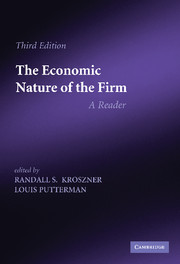Book contents
- Frontmatter
- Contents
- Editors' preface
- Reintroducing The Economic Nature of the Firm
- Part I Within and among firms: the division of labor
- 1 From The Wealth of Nations
- 2 From Capital
- 3 From Risk, Uncertainty, and Profit
- 4 From The Modern Corporation and Private Property
- 5 The use of knowledge in society
- 6 Corporate governance
- Part II The scope of the firm
- Part III The employment relation, the human factor, and internal organization
- Part IV Finance and the control of the firm
- References
- References
4 - From The Modern Corporation and Private Property
Published online by Cambridge University Press: 05 June 2014
- Frontmatter
- Contents
- Editors' preface
- Reintroducing The Economic Nature of the Firm
- Part I Within and among firms: the division of labor
- 1 From The Wealth of Nations
- 2 From Capital
- 3 From Risk, Uncertainty, and Profit
- 4 From The Modern Corporation and Private Property
- 5 The use of knowledge in society
- 6 Corporate governance
- Part II The scope of the firm
- Part III The employment relation, the human factor, and internal organization
- Part IV Finance and the control of the firm
- References
- References
Summary
Property in transition
(Book I, chapter 1)
…The typical business unit of the 19th century was owned by individuals or small groups; was managed by them or their appointees; and was, in the main, limited in size by the personal wealth of the individuals in control. These units have been supplanted in ever greater measure by great aggregations in which tens and even hundreds of thousands of workers and property worth hundreds of millions of dollars, belonging to tens or even hundreds of thousands of individuals, are combined through the corporate mechanism into a single producing organization under unified control and management.…
Such an organization of economic activity rests upon two developments, each of which has made possible an extension of the area under unified control. The factory system, the basis of the industrial revolution, brought an increasingly large number of workers directly under a single management. Then, the modern corporation, equally revolutionary in its effect, placed the wealth of innumerable individuals under the same central control. By each of these changes the power of those in control was immensely enlarged and the status of those involved, worker or property owner, was radically changed. The independent worker who entered the factory became a wage laborer surrendering the direction of his labor to his industrial master. The property owner who invests in a modern corporation so far surrenders his wealth to those in control of the corporation that he has exchanged the position of independent owner for one in which he may become merely recipient of the wages of capital.
- Type
- Chapter
- Information
- The Economic Nature of the FirmA Reader, pp. 58 - 62Publisher: Cambridge University PressPrint publication year: 2009
References
- 17
- Cited by



